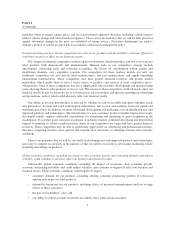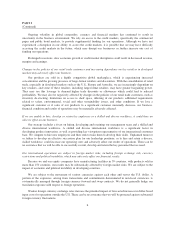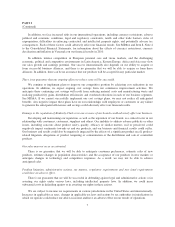Kimberly-Clark 2010 Annual Report Download - page 19
Download and view the complete annual report
Please find page 19 of the 2010 Kimberly-Clark annual report below. You can navigate through the pages in the report by either clicking on the pages listed below, or by using the keyword search tool below to find specific information within the annual report.
PART II
(Continued)
Overview of Business
We are a global company focused on leading the world in essentials for a better life, with manufacturing
facilities in 36 countries and products sold in more than 150 countries. Our products are sold under such well-
known brands as Kleenex, Scott, Huggies, Pull-Ups, Kotex and Depend. We have four reportable global business
segments: Personal Care, Consumer Tissue, K-C Professional & Other, and Health Care. These global business
segments are described in greater detail in Item 8, Note 20 to the Consolidated Financial Statements.
In managing our global business, we believe that developing new and improved products, managing
commodity and currency risks, responding effectively to competitive challenges, obtaining and maintaining
leading market shares, controlling costs, and responding effectively to current and developing global economic
environments are important to our long-term success. The discussion and analysis of results of operations and
other related information will refer to these factors.
• Product innovation—Past results and future prospects depend in large part on product innovation. We
rely on our ability to develop and introduce new or improved products to drive sales and volume growth
and to achieve and maintain category leadership. In order to introduce new or improved products, the
technology to support those products must be acquired or developed. Innovation spending is directed
towards new or improved personal care, tissue, industrial wipers, safety and health care products and
nonwoven materials.
• Commodity and foreign currency risks—We are exposed to changes in commodity prices, and as a
multinational enterprise, we are also exposed to changes in foreign currency exchange rates. Our ability
to effectively manage these risks can have a material effect on our results of operations.
• Competitive environment—Past results and future prospects are significantly affected by the
competitive environment in which we operate. We experience intense competition for sales of our
principal products in our major markets, both domestically and internationally. Our products compete
with widely-advertised, well-known, branded products, as well as private label products, which are
typically sold at lower prices. We have several major competitors in most of our markets, some of which
are larger and more diversified. The principal methods and elements of competition include brand
recognition and loyalty, price, product innovation, quality and performance, and marketing and
distribution capabilities.
We increased promotional and strategic marketing spending in 2009 and 2010 to support new or
improved product introductions, further build brand equity and enable competitive pricing in order to
protect the position of our products in the market. We expect competition to continue to be intense in
2011.
• Market shares—Achieving leading market shares in our principal products in key categories has been an
important part of our past performance. We hold the number 1 or 2 share positions in more than
80 countries. Achieving and maintaining leading market shares is important because of ongoing
consolidation of retailers and the trend of leading merchandisers seeking to stock only the top
competitive brands.
• Cost controls—To maintain or improve our competitive position, we must control our manufacturing,
distribution and other costs. We have achieved cost savings from reducing material costs and
manufacturing waste, and realizing productivity gains, distribution efficiencies and overhead reductions
in our business segments. Our ability to control costs can be affected by changes in the price of pulp, oil
and other commodities we consume in our manufacturing processes.
• Global economic environment—Our business and financial results continue to be adversely affected by
global economic uncertainty and market volatility. Although it has become more challenging to predict
15
























